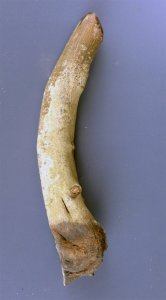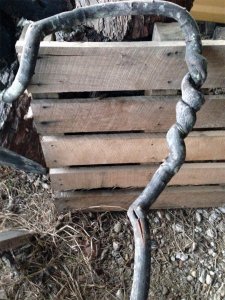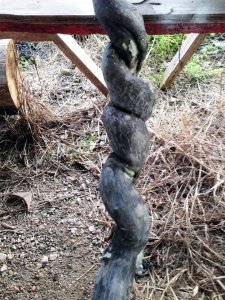The Backstory
I found this Alabama supplejack specimen quite by accident. I was clearing some brush that was crowding the roadway leading down to our pecan grove in Columbus about a year ago. Most of the brush that I was cutting was common stuff like Hackberry, Ash, Prickly Ash, Yaupon, etc. However, when I was cutting one clump of brush I found a large vine in the midst of the other stuff that I had never seen before. It was in a bad place and had to come out with the other brush, but I cut it into a few smaller pieces and threw them in the back of my truck so I could research it later.
I spent almost as much time trying to identify this thing as you guys did on this contest. I studied every Texas plant guide that I could find on-line or in my own library, but I couldn't find anything that looked like this. The leaves did look similar to buckthorn tree leaves, but those are trees and this was a vine, so it didn't dawn on me that they could be closely related.
So I searched on. I finally found an old geological survey of Colorado County that looked interesting. It was primarily a soil and terrain report, but it did divide the county into a number of sections by soil type and listed some of the common plants found in each section. The report did not include a map - instead the sections were identified by mileage markers and milestones, so I had to figure out which section we were in from these descriptions. The plant list for our section of the county included one called Alabama supplejack - it was the only one that I had never heard of before, so I looked it up and there was my vine.
I knew right then that this would be a great IAP wood ID candidate - especially when I could not find any mention of it in any of the IAP archives. I was just hoping that it would make a decent pen.
Here's some photos of the vine that I found. The first is the "trunk" nearest the ground. Supposedly Alabama supplejack can get up to 6" in diameter - this one was a little under 3" at the base. I am saving this largest piece for bottlestoppers, mini-birdhouses or such. I painted the ends and stored it in a plastic bag so it will dry slowly.
I cut some blanks from a section of the vine that was about 1.5" in diameter, painted the ends and stacked them to dry. Even with the ends painted these things split badly. Fortunately, they vine was large enough that I could make a pen of them even with the splits.
The remaining piece is about 6 feet long and ranges from 1.5" to 1" in diameter. Being a long piece, it is drying slowly enough that the splitting is minimal. I'll let this dry for a few more months but it should yield a number of decent pen blanks.
The third photo is a close up of the twisted part of the vine. No wonder that one of its AKAs is "stranglevine".






